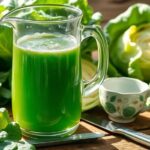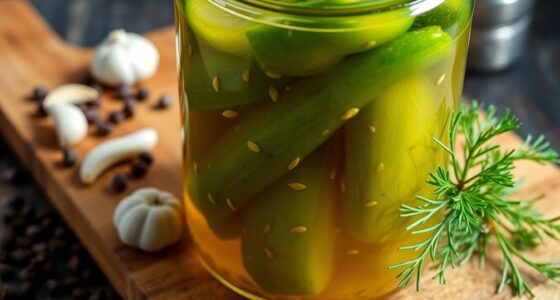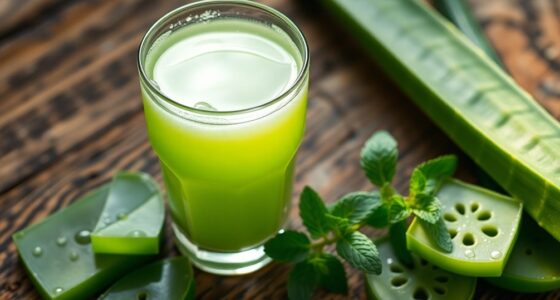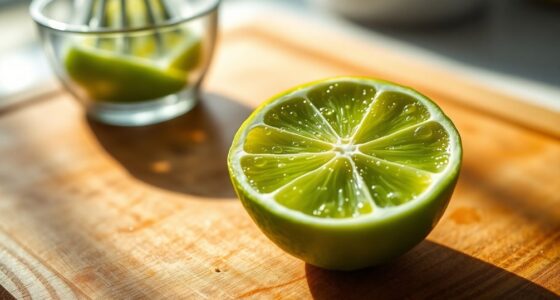To make parsley juice, start by washing fresh flat-leaf parsley and cutting off the bottom third of the stems. Combine the parsley with cucumber, green apple, ginger, and lemon juice in a blender or masticating juicer, adding a bit of water if needed. Blend until smooth, then serve immediately for the best flavor and nutrients. This healthy drink is packed with vitamins. Stick around to explore tips on storage and health benefits!
Key Takeaways
- Choose fresh flat-leaf parsley, ensuring it is free from wilting or discoloration for the best flavor and health benefits.
- Wash parsley thoroughly, cut off the bottom third of the stems, and prepare complementary ingredients like cucumber and green apple.
- Use a high-powered blender or masticating juicer to combine parsley, apple, lemon juice, ginger, and water until smooth.
- Serve the juice immediately to maximize freshness and nutrient retention; store leftovers in an airtight glass container for up to 24 hours.
- Be aware of health considerations, especially for pregnant individuals or those on blood thinners, and consult healthcare professionals if needed.
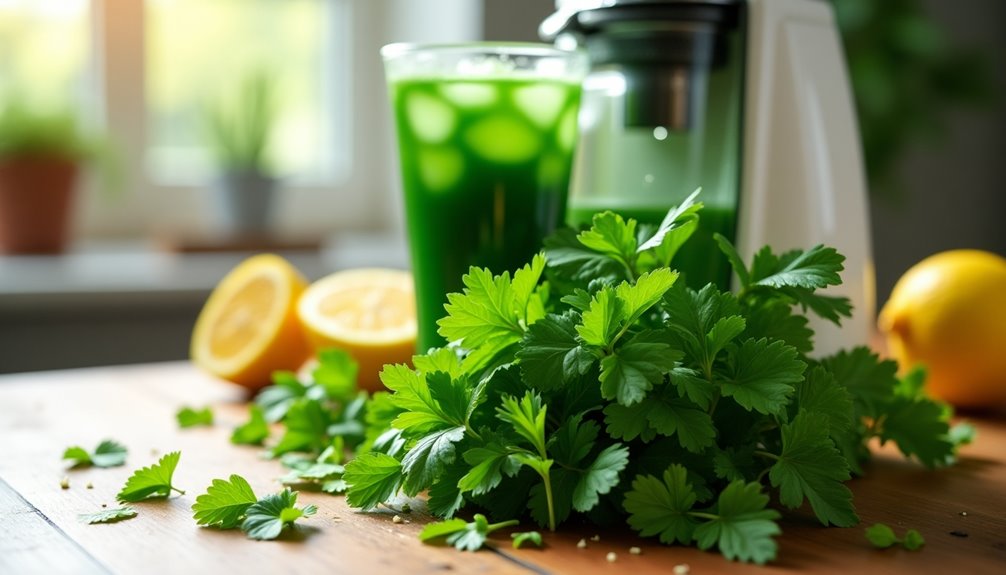
Making parsley juice is a refreshing way to boost your health and enjoy the vibrant flavors of fresh ingredients. Packed with numerous health benefits, parsley juice can help reduce inflammation while offering a delightful taste. To get started, you'll want to choose your parsley wisely. Flat-leaf parsley is generally preferred for juicing due to its robust flavor, but don't shy away from curly parsley if that's what you have on hand.
First, wash and prepare your parsley. Cut off the bottom third of the stems to ensure cleanliness before juicing. This step is crucial to avoid any gritty texture in your juice.
Once your parsley is ready, it's time to gather some complementary ingredients that will enhance both the flavor and nutritional profile of your juice. You can include ingredients like cucumber, apple, fresh ginger, and lemon juice. These ingredients not only add taste but also boost the detoxifying properties of your parsley juice.
If you're using a high-powered blender, combine one bunch of parsley, one cored and chopped green apple, the juice of half a lemon, a sliver of fresh ginger, and about one and a half cups of water. Blend until smooth to achieve a refreshing consistency.
If you're using a masticating juicer, simply feed these ingredients through the machine, which extracts the juice while preserving more nutrients. The combination of parsley and these complementary ingredients creates a delicious and healthy drink that you'll love.
After blending, serve your parsley juice immediately for maximum freshness and health benefits. The vibrant green color and zesty aroma will surely entice your senses. If you have any leftovers, store them in an airtight glass container in the refrigerator for up to 24 hours. However, it's best to consume it right away to fully enjoy the nutrients and flavors.
While parsley juice is a powerhouse of vitamins, especially vitamin K, it's important to consume it mindfully. If you're pregnant or on blood thinners, be cautious with your intake due to its high vitamin K content. Always consult with a healthcare professional if you have any concerns.
Incorporating parsley juice into your daily routine can significantly contribute to your overall well-being. With its ability to reduce inflammation and its detoxifying properties, this juice offers more than just a tasty drink.
Frequently Asked Questions
What Is the Best Way to Juice Parsley?
If you want to juice parsley effectively, using a masticating juicer is your best bet. It extracts juice while keeping nutrients intact.
Start by washing the parsley thoroughly and trimming the stems for optimal juicing.
For a better yield, mix parsley with high-water content ingredients like cucumber or apple, and a touch of fresh ginger for flavor.
If you don't have a juicer, blend it with water and strain for a refreshing drink.
Is Drinking Parsley Juice Good for You?
Yes, drinking parsley juice is good for you!
It's packed with antioxidants that fight inflammation and may help reduce cancer risk. You'll benefit from its high vitamin K content, supporting bone health and blood clotting.
Plus, it offers antibacterial properties, improving skin health and freshening your breath. Drinking it can also aid digestion and reduce bloating, making it a nutritious addition to your diet.
Just remember to consult a doctor if you're pregnant or on blood thinners!
How Do You Make Parsley Water?
Imagine crisp, green parsley swaying gently in a cool breeze.
To make parsley water, you'll start by washing a handful, then trim off the bottom third of the stems.
Place the fresh parsley in a pitcher, fill it with water, and let it steep in the fridge for at least 2 hours.
When you're ready, strain out the leaves, and enjoy this refreshing drink that's both hydrating and subtly flavorful!
Does Parsley Burn Belly Fat?
Parsley alone doesn't burn belly fat, but it can support your weight loss efforts.
Its high fiber content helps with digestion and keeps you feeling full, which may lower overall calorie intake.
Plus, parsley's antioxidants can reduce inflammation, and its diuretic properties might decrease water retention, giving a temporary flatter appearance.
To effectively shed belly fat, you should combine parsley with a balanced diet and regular exercise for the best results.
Conclusion
Making parsley juice is a breeze and a fantastic way to boost your health. With just a few simple steps, you've created a nutrient-packed drink that's as refreshing as a cool breeze on a hot summer day. So, grab that juicer and indulge in the vibrant flavors and benefits of parsley. You'll feel like you've unlocked the secret to wellness in a glass! Cheers to your new favorite health elixir!
Cindy thoroughly researches juicing trends, techniques, and recipes to provide readers with practical advice and inspiration. Her writing style is accessible, engaging, and designed to make complex concepts easy to understand. Cindy’s dedication to promoting the advantages of juicing shines through her work, empowering readers to make positive changes in their lives through the simple act of juicing.








